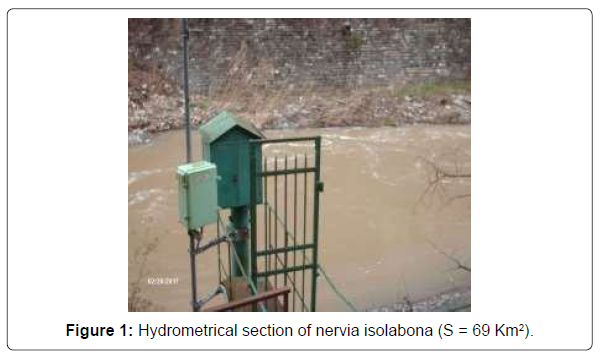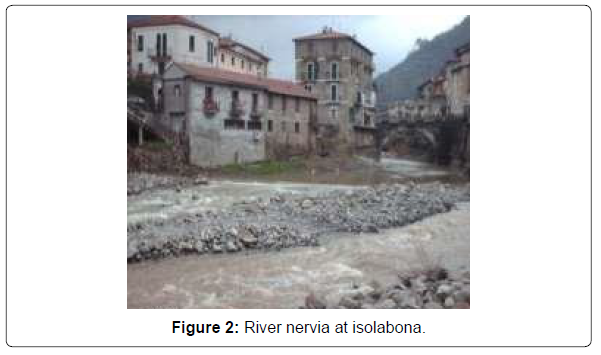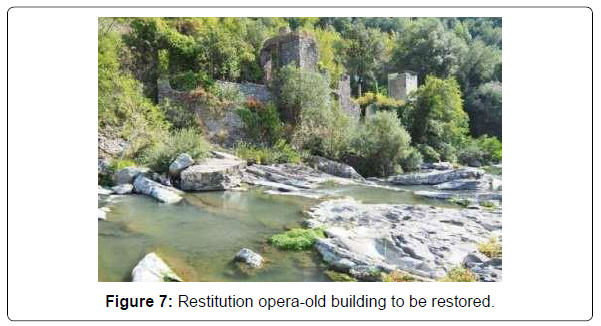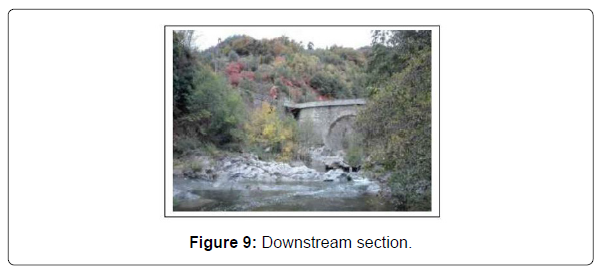Mini Hydro Restoration, Case of Extraordinary Competition: Real Case Report
Received: 27-Jul-2021 / Accepted Date: 11-Aug-2021 / Published Date: 18-Aug-2021 DOI: 10.4172/2576-1463.1000242
Abstract
This study deals with the task of restoring a small hydropower plant located in Italy next to the French coast. Two similar projects, belonging to two different companies, have been advanced. The local Authorities and law according to the Italian Royal Act dated 1933 allow two or more proposals to be in competition into 30 days, alternatively known as ordinary competition. But after this 30 days the latest proposal presented has to demonstrate and added value in order to be selected and win the competition. The bonus is generally referred to the better quality of water released to fulfil environmental flow assessment and protection of the river course in face of the given withdrawn. Another plus is represented by the agreement an areas where the plant should be placed, namely an agreement between and stakeholders.
The article under study according to the royal law (RD 1933), clearly states
❖ Among different and rival proposals the one selected is the one which presents the most rational use of hydric sources according to the given criteria
❖ Actual satisfaction level of the essential needs of the concurrent also considering water public services of acqueduct or irrigation purposes.
❖ Better possibilities of water respect the given usage
❖ Quantitative and qualitative safeguards of the river body
❖ The amount of released water should be more than the one withdrawn
Among all other criteria the selected proposal is the one which guarantees best economic and technical conditions to be built. For sure all the above mentioned criteria are very realistic and are completely shareable.
Introduction
The hydropower plant under study is located in the small town of Pigna, Italy next to the French border. The plant shows a power production of 300 kW and mean yearly energy equals to E 286 000 k Wh/year. Designed withdrawn equals to Q=1 m3/s while environmental flow EF equals to 100 l/s. Hydraulic total Jump reaches value of 8.64 m, without losses or frictions.. The river under study is named Nervia and the catchment’s area has a size of 69 k m2 at the section of withdrawn. Direct biological surveys conducted initially in two spots : before, the capture weir and before the restitution opera and , subsequently an inner additional section has been added. Last two sections have demonstrated a weak existence of eels and vairons.
Since the vairons have demonstrated to have less swimming abilities than the eels a bypass for vairons has been designed as fish passage for total sampled species. In addition to this biological surveys of surface water quality have been conducted. In the inner path between the catchment weir and the restitution opera there is a purifier located on the right side of the bank. Biological surveys conducted 50 m downstream the purifier have demonstrated that quality of water is definately high although there are some microbes due to Eschierichia coli. Company proposes demolition of Eschiarichia coli bacteria using proper chemical additives.
Architectural proposal
The project proposes also the recovery of an ancient and hystorical building which is dated 1850 and contextually the demolition of the Electrical cabin which has been realized in late 1960s. Still the cabin is totally artificial if compared to the remaining part of the building. A sand sedimentator shaped as a big box is also placed 300 mt after the capture weir. The bank introduces a Banki Mitchell turbine and a transform a system to reconvert the high tension into median tension. Both the devices are located inside the old hydro plant building [1-4].
Catchment description
Nervia catchment has experienced several flash floods especially concentrated in the month of November. Water values rise up to peak of 350 m3/s starting from 1-2 m3/s as average yearly value. Time concentration varies from 3 up to 7 hours roughly. Catchment’s size closed at the capture weir is equal to 69 k m2 while the hydrometrical section is located 7 km downstream. Stream flow measures have been conducted using a current meter of 6 cm of ratio. The measures have been conducted upstream and downstream the capture weir , every month for a total of 24 measures in a year.
Technical descriptions
Restoring the mentioned hydropower located in Pigna town entails a power production of P =300 k W and mean yearly energy equals to E=286000 k wh/year having the environmental flow ranging from 100 to 500 l/s and design stream flow Qd=1 m3/s. Distance between capture weir and restitution opera equals to 700 m and total head equals to H = 8.64m.
Figures 1-9 reports the ratio between the withdrawn water volume and the corresponding total volume. Such a ratio is represented by the red curve eta while beta represents the ratio between the withdrawn water volume and the corresponding volume which would be available in case of maximum stream flow was at disposal all the year long. The intersections of the two curves gives a streamflow value equal to 1.255 m3/s which corresponds to a duration of 76 days /year. Therefore a withdrawal of 1 m3/s seems to be justified. If we consider a withdrawal value equal to 900 l/s and we guarantee an environmental release of 100 l/s it comes out that the turbinable streamflow is avaliable 334 days/ year. Conversely to 900 l/s is associated a duration of 92 giorni/year., while to Q = 600 l/s the related duration is 122 days/year.
If we analyse the streamflow duration curve built for the long hydrological year (which is equal to 10 years of observed data into the period 1951-1971) and synthesized for characteristic durations for the period of reference we obtain Table 1. The total head htot(m) losses is expressed by htot=k*Q 2.
| m3/s | Q(10) | Q(30) | Q(60) | Q(91) | Q(135) | Qmean | Q(182) | Q(274) | Q(355) |
| Nervia | 19.60 | 6.41 | 3.12 | 2.07 | 1.38 | 2.77 | 0.87 | 0.39 | 0.16 |
Table 1: Streamflow duration curve data for the long hydrological year.
Where Q (m3/s) is the withdrawn stream flow (which is between a value of 900 l/s and a minimum value above 100l/s) e K (s2/m5) is a constant value. D (m) is the pipe diameter, g is the gravity acceleration, L is the pipe length, e kn is the sum of the head losses and lambda is the roughness coefficient.
The roughness coefficient of the Darcy Weisbach formula is evaluated from the much more known Gaukler Strikler coefficient. The streamflow inside the pipe (ks=110 m1/3/s) has an inner diameter of 700 mm and total length of 350 m. Values are synthesized in the following Table 2.
| Number | N | 1 |
| Diameter | D | 0.7 |
| Lenght | L | 350 |
| Roughness 1 | ks | 110 |
| Roughness 2 | l | 0.011 |
| Localized losses | Km | 0.5 |
| Total losses | Tm | 2.17 |
Table 2: Plant characteristic.
Concerning biological surveys, two measures have been conducted ante opera located before and after the capture weir with a internal distance of 700 m. For the upstream section samples of Anguilla, Barbus Plebejus, and Telestes Muticellus have been discovered; conversely, downstream sporadic group of Italic Barbus have been founded.
This part of the Nervia river presents typical characteristics of the endemic taxon alternatively known as Barbus Plebejus which can be easily detected by the body shape and the number of scales over the lateral side which generally overtakes 62 cm, as expressed by Figure 10 which displays a sampled fish in this conducted campaign.
Figures 11 and 12 report the distribution of the Telestes Muticellus and Barbus in three sampled sections: the first one in the upstream section, the second one in between and the last one in the downstream section. Colours for the referred sections are respectively: Blue, Red and Green [5-9].
Conclusions
Hydropower approval consists of three Bureaus tables.
1. Authorization from the main office of the Region (in such a case Genova) for the evaluation of environmental impact.
2. Authorization from the second Office of the Region for water concession
3. Authorization from the third office of the Region, Imperia country, for the occupation of area which in case the agreement between stakeholders and properties is not settled can be obtained through the expropriation procedure.
The expropriation procedure considers the possibility to gain the areas for anybody who has already received water concession calming the right to produce clean energy (hydropower production) for public purposes.
References
- Arnold EN, Burton JA (1978) A field guide to the reptiles and amphibians of britain and europe. Collins, London.
- Bianco PG (1998) Diversity of barbinae fishes in southern europe with description of a new genus and a new species (cyprinidae). Ital J Zool 65:125-136
- Geroudet P (1965) Les rapaces diurnes et nocturnes d'Europe. Delachaux et Niestle, 3rd Edn, Paris, France.
- Renard Le, Blaireau Le, Fouine La. Office National de la Chasse et de la Faune Sauvage., Une méthode pour la rèconaissance des carnivores.
- Kottelat M, Frejoh J (2007) Handbook of european freshwater fishes. Publications Kottelat Cornol, Switzerland, 646.
- Peterson RT, Mountfort G, Hollom PADGuide des oiseaux d'Europe. Delachaux et Niestle, Paris, 1962.
Citation: Carcano E, Drelan BN (2021) Mini Hydro Restoration, Case of Extraordinary Competition: Real Case. Innov Ener Res, 10: 242. DOI: 10.4172/2576-1463.1000242
Copyright: © 2021 Carcano E, et al. This is an open-access article distributed under the terms of the Creative Commons Attribution License, which permits unrestricted use, distribution, and reproduction in any medium, provided the original author and source are credited.
Select your language of interest to view the total content in your interested language
Share This Article
Recommended Journals
Open Access Journals
Article Tools
Article Usage
- Total views: 2632
- [From(publication date): 0-2021 - Sep 23, 2025]
- Breakdown by view type
- HTML page views: 1822
- PDF downloads: 810












